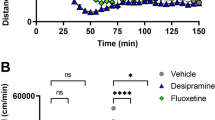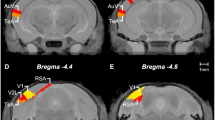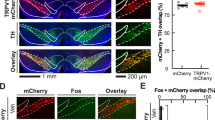Abstract
The prefrontal cortex (PFC) and extended frontostriatal circuitry play a critical role in executive cognitive processes that guide goal-directed behavior. Dysregulation of frontostriatal-dependent cognition is implicated in a variety of cognitive/behavioral disorders, including addiction and attention deficit hyperactivity disorder (ADHD). Psychostimulants exert dose-dependent and opposing actions on frontostriatal cognitive function. Specifically, low and clinically-relevant doses improve, while higher doses associated with abuse and addiction impair, frontostriatal-dependent cognitive function. Frontostriatal cognition is supported by the coordinated activity of neurons across this circuit. To date, the neural coding mechanisms that support the diverse cognitive actions of psychostimulants are unclear. This represents a significant deficit in our understanding of the neurobiology of frontostriatal cognition and limits the development of novel treatments for frontostriatal cognitive impairment. The current studies examined the effects of cognition-enhancing and cognition-impairing doses of methylphenidate (MPH) on the spiking activity of dorsomedial PFC (dmPFC) and dorsomedial striatal (dmSTR) neurons in 17 male rats engaged in a working memory task. Across this frontostriatal circuit, we observed opposing actions of low- and high-dose MPH on the population-based representation of delay: low-dose strengthened, while high-dose weakened, representation of this event. MPH elicited a more complex pattern of actions on reward-related signaling, that were highly dose-, region- and neuron-dependent. These observations provide novel insight into the neurophysiological mechanisms that support the cognitive actions of psychostimulants.
This is a preview of subscription content, access via your institution
Access options
Subscribe to this journal
Receive 13 print issues and online access
$259.00 per year
only $19.92 per issue
Buy this article
- Purchase on Springer Link
- Instant access to full article PDF
Prices may be subject to local taxes which are calculated during checkout



Similar content being viewed by others
References
Bush G, Valera EM, Seidman LJ. Functional neuroimaging of attention-deficit/hyperactivity disorder: a review and suggested future directions. BiolPsychiatry. 2005;57:1273–84.
Goldstein RZ, Volkow ND. Drug addiction and its underlying neurobiological basis: neuroimaging evidence for the involvement of the frontal cortex. Am J Psychiatry. 2002;159:1642–52.
Berridge CW, Devilbiss DM, Andrzejewski ME, Arnsten AF, Kelley AE, Schmeichel B, et al. Methylphenidate preferentially increases catecholamine neurotransmission within the prefrontal cortex at low doses that enhance cognitive function. BiolPsychiatry. 2006;60:1111–20.
Mehta MA, Sahakian BJ, Robbins TW. Comparative Psychopharmacology of Methylphenidate and Related Drugs in Human Volunteers, Patients with ADHD, and Experimental Animals. Stimul. Drugs ADHD Basic Clin. Neurosci. New York: Oxford University Press; 2001. p. 303–31.
Rapoport JL, Inoff-Germain G. Responses to methylphenidate in attention-deficit/hyperactivity disorder and normal children: update 2002. J Atten Disord. 2002;6:S57–60.
Tannock R, Schachar RJ, Carr RP, Logan GD. Dose-response effects of methylphenidate on academic performance and overt behavior in hyperactive children. Pediatrics. 1989;84:648–57.
Kuczenski R, Segal DS. Locomotor effects of acute and repeated threshold doses of amphetamine and methylphenidate: relative roles of dopamine and norepinephrine. J Pharmacol Exp Ther. 2001;296:876–83.
Kuczenski R, Segal DS. Exposure of adolescent rats to oral methylphenidate: preferential effects on extracellular norepinephrine and absence of sensitization and cross-sensitization to methamphetamine. J Neurosci. 2002;22:7264–71.
Morein-Zamir S, Simon Jones P, Bullmore ET, Robbins TW, Ersche KD. Prefrontal hypoactivity associated with impaired inhibition in stimulant-dependent individuals but evidence for hyperactivation in their unaffected siblings. Neuropsychopharmacology. 2013;38:1945–53.
Rebec GV, Bashore TR. Critical issues in assessing the behavioral effects of amphetamine. Neurosci Biobehav Rev. 1984;8:153–9.
Segal DS. Behavioral and neurochemical correlates of repeated d-amphetamine administration. Adv Biochem Psychopharmacol. 1975;13:247–62.
Cubillo A, Halari R, Smith A, Taylor E, Rubia K. A review of fronto-striatal and fronto-cortical brain abnormalities in children and adults with Attention Deficit Hyperactivity Disorder (ADHD) and new evidence for dysfunction in adults with ADHD during motivation and attention. Cortex. 2012;48:194–15.
Ragozzino ME. The contribution of the medial prefrontal cortex, orbitofrontal cortex, and dorsomedial striatum to behavioral flexibility. Ann N Y Acad Sci. 2007;1121:355–75.
Spencer R, Devilbiss D, Berridge C. The cognition-enhancing effects of psychostimulants involve direct action in the prefrontal cortex. Biol Psychiatry. 2015;77:940–50.
Kesner RP. Subregional analysis of mnemonic functions of the prefrontal cortex in the rat. Psychobiology. 2000;28:219–28.
Dalley JW, Cardinal RN, Robbins TW. Prefrontal executive and cognitive functions in rodents: neural and neurochemical substrates. Neurosci Biobehav Rev. 2004;28:771–84.
Spencer RC, Klein RM, Berridge CW. Psychostimulants act within the prefrontal cortex to improve cognitive function. Biol Psychiatry. 2012;72:221–7.
Gabbott PLA, Warner TA, Jays PRL, Salway P, Busby SJ. Prefrontal cortex in the rat: Projections to subcortical autonomic, motor, and limbic centers. J Comp Neurol. 2005;492:145–77.
Vertes RP. Differential projections of the infralimbic and prelimbic cortex in the rat. Synapse. 2004;51:32–58.
Balleine BW, Peak J, Matamales M, Bertran-Gonzalez J, Hart G. The dorsomedial striatum: an optimal cellular environment for encoding and updating goal-directed learning. Curr Opin Behav Sci. 2021;41:38–44.
Kuczenski R, Segal DS. Effects of methylphenidate on extracellular dopamine, serotonin, and norepinephrine: comparison with amphetamine. J Neurochem. 1997;68:2032–7.
Fishman RHB, Feigenbaum JJ, Yanai J, Klawans HL. The relative importance of dopamine and norepinephrine in mediating locomotor activity. Prog Neurobiol. 1983;20:55–88.
Koob GF, Sanna PP, Bloom FE. Neuroscience of addiction. Neuron. 1998;21:467–76.
Kuczenski R, Segal DS. Regional norepinephrine response to amphetamine using dialysis: comparison with caudate dopamine. Synapse. 1992;11:164–9.
Ventura R, Cabib S, Alcaro A, Orsini C, Puglisi-Allegra S. Norepinephrine in the prefrontal cortex is critical for amphetamine-induced reward and mesoaccumbens dopamine release. J Neurosci. 2003;23:1879–85.
Hupalo S, Martin AJ, Green RK, Devilbiss DM, Berridge CW. Prefrontal Corticotropin-Releasing Factor (CRF) neurons act locally to modulate frontostriatal cognition and circuit function. J Neurosci. 2019;39:2080–90.
Devilbiss DM, Spencer RC, Berridge CW. Stress degrades prefrontal cortex neuronal coding of goal-directed behavior. Cereb Cortex. 2017;27:2970–83.
Fuster JM, Alexander GE. Neuron activity related to short-term memory. Science. 1971;173:652–4.
Schultz W, Romo R. Role of primate basal ganglia and frontal cortex in the internal generation of movements. I. Preparatory activity in the anterior striatum. ExpBrain Res. 1992;91:363–84.
Akhlaghpour H, Wiskerke J, Choi JY, Taliaferro JP, Au J, Witten IB. Dissociated sequential activity and stimulus encoding in the dorsomedial striatum during spatial working memory. eLife. 2016;5:e19507.
Arnsten AFT. Catecholamine and second messenger influences on prefrontal cortical networks of ‘representational knowledge’: a rational bridge between genetics and the symptoms of mental illness. Cereb Cortex N Y N 1991. 2007;17:i6–15. Suppl 1.
Mitchell JF, Sundberg KA, Reynolds JH. Differential attention-dependent response modulation across cell classes in macaque visual area V4. Neuron. 2007;55:131–41.
Berke JD, Okatan M, Skurski J, Eichenbaum HB. Oscillatory entrainment of striatal neurons in freely moving rats. Neuron. 2004;43:883–96.
Batuev AS, Kursina NP, Shutov AP. Unit activity of the medial wall of the frontal cortex during delayed performance in rats. Behav Brain Res. 1990;41:95–102.
Horst NK, Laubach M. Working with memory: evidence for a role for the medial prefrontal cortex in performance monitoring during spatial delayed alternation. J Neurophysiol. 2012;108:3276–88.
Jung MW, Qin Y, McNaughton BL, Barnes CA. Firing characteristics of deep layer neurons in prefrontal cortex in rats performing spatial working memory tasks. Cereb Cortex N Y N 1991. 1998;8:437–50.
Goldman-Rakic PS. Cellular basis of working memory. Neuron. 1995;14:477–85.
D’Esposito M, Postle BR. The cognitive neuroscience of working memory. Annu Rev Psychol. 2015;66:115–42.
Kubota K, Niki H. Prefrontal cortical unit activity and delayed alternation performance in monkeys. J Neurophysiol. 1971;34:337–47.
Sakai K, Rowe JB, Passingham RE. Active maintenance in prefrontal area 46 creates distractor-resistant memory. Nat Neurosci. 2002;5:479–84.
Fallon SJ, Cools R. Reward acts on the pFC to enhance distractor resistance of working memory representations. J Cogn Neurosci. 2014;26:2812–26.
Koob GF, Volkow ND. Neurocircuitry of addiction. Neuropsychopharmacology. 2010;35:217–38.
Wong CG, Stevens MC. The effects of stimulant medication on working memory functional connectivity in attention-deficit/hyperactivity disorder. Biol Psychiatry. 2012;71:458–66.
Tomasi D, Volkow ND, Wang GJ, Wang R, Telang F, Caparelli EC, et al. Methylphenidate enhances brain activation and deactivation responses to visual attention and working memory tasks in healthy controls. NeuroImage. 2011;54:3101–10.
Ramasubbu R, Goodyear BG. Methylphenidate modulates activity within cognitive neural networks of patients with post-stroke major depression: A placebo-controlled fMRI study. NeuropsychiatrDisTreat. 2008;4:1251–66.
Sheridan MA, Hinshaw S, D’Esposito M. Stimulant medication and prefrontal functional connectivity during working memory in ADHD: a preliminary report. J Atten Disord. 2010;14:69–78.
Ramasubbu R, Singh H, Zhu H, Dunn JF. Methylphenidate-mediated reduction in prefrontal hemodynamic responses to working memory task: a functional near-infrared spectroscopy study. Hum Psychopharmacol Clin Exp. 2012;27:615–21.
Mehta MA, Owen AM, Sahakian BJ, Mavaddat N, Pickard JD, Robbins TW. Methylphenidate enhances working memory by modulating discrete frontal and parietal lobe regions in the human brain. J Neurosci. 2000;20:RC65.
Arnsten AF. Through the looking glass: differential noradenergic modulation of prefrontal cortical function. Neural Plast. 2000;7:133–46.
Robbins TW, Arnsten AFT. The neuropsychopharmacology of fronto-executive function: monoaminergic modulation. Annu Rev Neurosci. 2009;32:267–87.
Spencer RC, Berridge CW. Receptor and circuit mechanisms underlying differential procognitive actions of psychostimulants. Neuropsychopharmacology. 2019;44:1820–7.
Arnsten AF. Catecholamine regulation of the prefrontal cortex. JPsychopharmacol. 1997;11:151–62.
Arnsten AF. Stress impairs prefrontal cortical function in rats and monkeys: role of dopamine D1 and norepinephrine Alpha-1 receptor mechanisms. ProgBrain Res. 2000;126:183–92.
Hashemnia S, Euston DR, Gruber AJ. Amphetamine reduces reward encoding and stabilizes neural dynamics in rat anterior cingulate cortex. eLife. 2020;9:e56755.
Haracz JL, Tschanz JT, Wang Z, White IM, Rebec GV. Striatal single-unit responses to amphetamine and neuroleptics in freely moving rats. Neurosci Biobehav Rev. 1993;17:1–12.
Kodama T, Kojima T, Honda Y, Hosokawa T, Tsutsui K, Watanabe M. Oral administration of methylphenidate (ritalin) affects dopamine release differentially between the prefrontal cortex and striatum: a microdialysis study in the monkey. J Neurosci. 2017;37:2387–94.
Rebec GV, White IM, Puotz JK. Responses of neurons in dorsal striatum during amphetamine-induced focused stereotypy. Psychopharmacology (Berl). 1997;130:343–51.
Surmeier DJ, Ding J, Day M, Wang Z, Shen W. D1 and D2 dopamine-receptor modulation of striatal glutamatergic signaling in striatal medium spiny neurons. Trends Neurosci. 2007;30:228–35.
Marinelli M, Piazza PV. Interaction between glucocorticoid hormones, stress and psychostimulant drugs. Eur J Neurosci. 2002;16:387–94.
Barsegyan A, Mackenzie SM, Kurose BD, McGaugh JL, Roozendaal B. Glucocorticoids in the prefrontal cortex enhance memory consolidation and impair working memory by a common neural mechanism. Proc Natl Acad Sci USA. 2010;107:16655–60.
Funding
This work was supported by the National Institutes of Health MH09863 (RCS); MH80813, MH116526 (CWB).
Author information
Authors and Affiliations
Contributions
RCS and CWB conceived the experiments. RCS and AJM executed the experiments. RCS and AJM, analyzed the data with assistance from DMD. RCS and CWB wrote the manuscript.
Corresponding author
Ethics declarations
Competing interests
The authors declare no competing interests.
Additional information
Publisher’s note Springer Nature remains neutral with regard to jurisdictional claims in published maps and institutional affiliations.
Supplementary information
Rights and permissions
Springer Nature or its licensor (e.g. a society or other partner) holds exclusive rights to this article under a publishing agreement with the author(s) or other rightsholder(s); author self-archiving of the accepted manuscript version of this article is solely governed by the terms of such publishing agreement and applicable law.
About this article
Cite this article
Spencer, R.C., Martin, A.J., Devilbiss, D.M. et al. Cognition-enhancing and cognition-impairing doses of psychostimulants exert opposing actions on frontostriatal neural coding of delay in working memory. Neuropsychopharmacol. 49, 837–844 (2024). https://doi.org/10.1038/s41386-023-01738-6
Received:
Revised:
Accepted:
Published:
Issue Date:
DOI: https://doi.org/10.1038/s41386-023-01738-6



